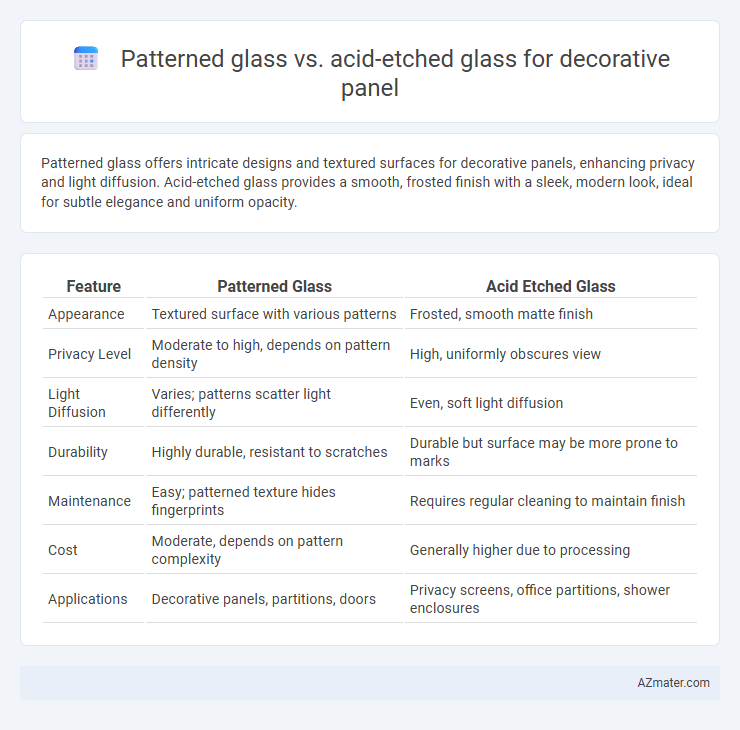Patterned glass offers intricate designs and textured surfaces for decorative panels, enhancing privacy and light diffusion. Acid-etched glass provides a smooth, frosted finish with a sleek, modern look, ideal for subtle elegance and uniform opacity.
Table of Comparison
| Feature | Patterned Glass | Acid Etched Glass |
|---|---|---|
| Appearance | Textured surface with various patterns | Frosted, smooth matte finish |
| Privacy Level | Moderate to high, depends on pattern density | High, uniformly obscures view |
| Light Diffusion | Varies; patterns scatter light differently | Even, soft light diffusion |
| Durability | Highly durable, resistant to scratches | Durable but surface may be more prone to marks |
| Maintenance | Easy; patterned texture hides fingerprints | Requires regular cleaning to maintain finish |
| Cost | Moderate, depends on pattern complexity | Generally higher due to processing |
| Applications | Decorative panels, partitions, doors | Privacy screens, office partitions, shower enclosures |
Introduction to Decorative Glass Panels
Decorative glass panels enhance interior design by combining functionality with aesthetic appeal, using materials like patterned glass and acid etched glass. Patterned glass features textured surfaces created by rolling molten glass over engraved rollers, offering privacy while allowing light diffusion. Acid etched glass provides a smooth, frosted finish achieved through acid treatment, delivering a sleek, modern look with subtle translucency ideal for contemporary decorative panels.
What is Patterned Glass?
Patterned glass, also known as textured glass, features raised or embossed designs created during the manufacturing process to add visual interest and privacy while allowing natural light to pass through. It is commonly used in decorative panels for its durability and ability to obscure visibility without blocking light completely. Unlike acid etched glass, which achieves a frosted appearance through chemical treatment, patterned glass relies on physical patterns for aesthetic and functional appeal.
What is Acid Etched Glass?
Acid etched glass is a type of decorative glass created by exposing the surface to hydrofluoric acid, resulting in a frosted, matte finish that diffuses light softly while maintaining translucency. Unlike patterned glass, which features embossed or pressed designs, acid etched glass offers a smooth, uniform texture that enhances privacy without obstructing light. This technique is highly favored for decorative panels in interior design due to its elegant, understated appearance and versatile application.
Visual Appearance: Patterned vs Acid Etched Glass
Patterned glass offers distinct, raised textures that create dynamic light refraction and a more pronounced tactile surface, enhancing decorative panels with bold visual patterns. Acid etched glass features a smooth, frosted finish that diffuses light evenly, providing a subtle, elegant appearance ideal for privacy without reducing brightness. The choice between patterned and acid etched glass depends on the desired balance between texture prominence and soft light diffusion in interior design applications.
Light Transmission and Privacy Comparison
Patterned glass offers varied light transmission depending on the design, providing moderate privacy by obscuring direct visibility while allowing diffused natural light to enter. Acid etched glass delivers uniform light diffusion with higher privacy levels, as its frosted surface scatters light effectively and minimizes transparency. Both options balance aesthetics and functionality, but patterned glass is preferable when decorative texture and partial view retention are desired, whereas acid etched glass is ideal for maximum privacy with consistent light softening.
Durability and Maintenance Differences
Patterned glass offers high durability due to its textured surface, which effectively hides fingerprints and minor scratches, making it ideal for high-traffic decorative panels. Acid etched glass, while providing a smooth, elegant matte finish, is more susceptible to showing smudges and requires delicate cleaning with non-abrasive materials to maintain its appearance. Maintenance of patterned glass is generally easier and less frequent, whereas acid etched glass demands careful upkeep to preserve its uniform frosted look.
Design Flexibility and Customization
Patterned glass offers extensive design flexibility with a variety of textures and motifs that can be tailored to specific aesthetic themes, allowing intricate patterns and vibrant visual effects. Acid etched glass provides a more subtle, matte finish that softens light diffusion while enabling customization through precise control over opacity and design depth. Both options allow for unique customization, but patterned glass excels in bold, graphic designs whereas acid etched glass suits minimalist, elegant applications.
Cost Considerations: Patterned vs Acid Etched
Patterned glass generally offers lower production costs due to standardized manufacturing processes and quicker fabrication times compared to the more labor-intensive acid etching technique. Acid etched glass involves chemical treatments that increase material and labor expenses, resulting in higher overall pricing for decorative panels. Budget-conscious projects often favor patterned glass for its cost efficiency while still achieving aesthetic appeal.
Common Applications for Each Glass Type
Patterned glass is commonly used in decorative panels for doors, partitions, and windows where privacy is desired without sacrificing light transmission, often found in residential and office interiors. Acid etched glass is frequently applied in areas requiring a smooth, uniform frosted appearance, such as bathroom panels, shower enclosures, and corporate signage to enhance privacy and aesthetic appeal. Both glass types are popular in commercial and architectural projects, chosen based on the desired texture and level of translucency.
Choosing the Best Decorative Glass for Your Project
Patterned glass offers varied textures and designs that enhance privacy while allowing light transmission, making it ideal for decorative panels in both residential and commercial spaces. Acid etched glass provides a smooth, frosted finish with consistent opacity, perfect for modern aesthetics requiring subtle elegance and glare reduction. Selecting the best decorative glass depends on desired light diffusion, visual impact, and maintenance needs, with patterned glass excelling in texture diversity and acid etched glass standing out for uniform matte appearance.

Infographic: Patterned glass vs Acid etched glass for Decorative panel
 azmater.com
azmater.com